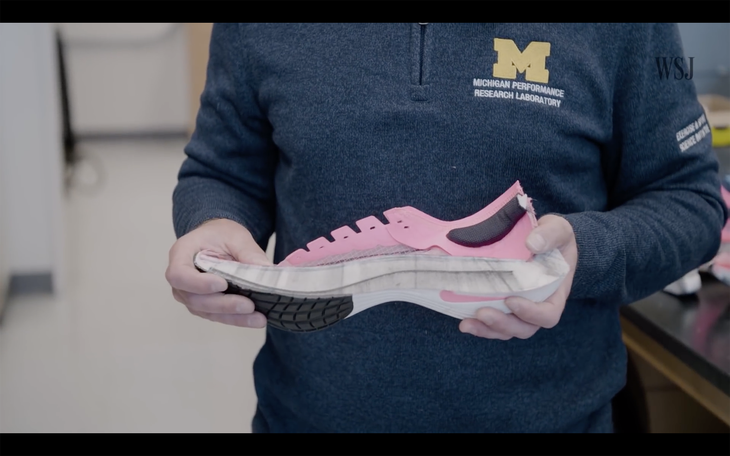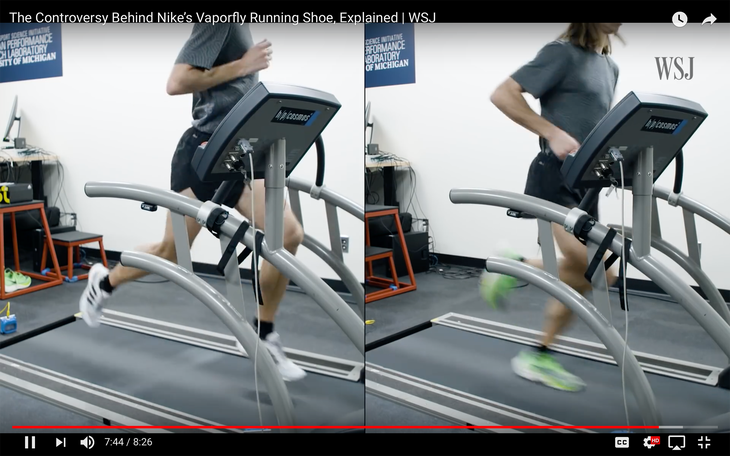On January 23, the Wall Street Journal posted an excellent 8-minute video on YouTube summarizing the controversy around Nike’s Vaporfly shoes. By Sunday afternoon, the video had been seen 2.7 million times, and more than 6000 viewers had left comments.
The video summarizes the Vaporfly story, gets comments from veteran coach Peter Thompson (once an IAAF official), looks briefly at Eliud Kipchoge’s and Brigid Kosgei’s superfast 2019 marathons, and visits a University of Michigan sports science lab. There, a Nike Vaporfly shoe is buzz sawed in half to reveal its foam and carbon plate. Also, biomechanist Geoff Burns monitors 2:17 marathon Juris Silenieks while Silenieks runs a treadmill mile in a pair of Vaporfly Next% and a pair of Adidas Adios Boosts.

The only thing missing: The WSJ video revealed no data about the comparison treadmill runs. Did the shoes function differently?
The Comparison Test Results
To find out, we contacted Burns and Silenieks. Here’s what we learned.
First, the protocol: Silenieks ran first in the Nikes, then in the Adidas. In both shoes, he ran a mile with 880-yard splits of 3:00, then 2:30. In other words, he ran a half-mile at 6-minute pace followed by a half at 5-minute pace.
Results: At the end of the 1-mile efforts, his heart rate was about 5 beats/minute lower in the Vaporfly vs. Boost. His stride frequency was about 3 strides/minute lower in the Vaporfly, meaning he took longer strides, possibly from greater energy return.
Burns makes no claims that the side-by-side testing was scientifically controlled, and he took no measurements of oxygen consumption, the “gold standard” in this sort of test. “It was a crude approach, but our mechanical measurements mirrored the Colorado study in terms of step frequency and stride length,” says Burns.
Silienieks was a 14:28 5000-meter runner at Syracuse University (class of 2016) under coach Chris Fox. Now 27, he qualified for the 2020 Marathon Trials at the 2018 Philadelphia Marathon with a 2:17:37. He currently lives just outside Lansing, Michigan, but was in Charlottesville, Virginia, for some pre-Trials training with Fox’s Reebok Boston team when we reached him. We asked a few questions about the WSJ video and more. Here are his responses.

Have you run in the Vaporflys before?
Yes. I wore them when I ran 2:17 in Philadelphia in 2018, and I wore the Nexts last November in Indianapolis. I was hoping for a 2:15 in Indianapolis, and was on pace at 19 miles, but then my hamstrings tightened up due to a disc problem I had last fall. I finished in 2:20:56.
How did the shoes feel in your side-by-side test?
I noticed the biggest difference when I was running at 5-minute pace. In the Nexts, I was a bit wobbly at first, but once I found my rhythm, it almost got easier and easier. In the Adidas, my effort got much higher for the last minute.
The Nexts felt bouncier. It was weird—I could even hear a difference when I was warming up by jogging in place before getting on the treadmill. The Nexts were louder. It was as if I could hear them performing more work.
What do you think about the debate over the Nike shoes?
I go back and forth. Like most, I don’t want to go back to running on cinder tracks. Technology does a lot for us. But I think we might have to figure out some sort of restriction for the new shoes. Maybe it’s stack height. Maybe we should restrict or remove the plate. I don’t want to see shoes lead to unfair competitions.
How’s your Trials training?
It was great last fall before the disc problem. I was up around 110- to 125-miles a week, and hoping for a top 30 to 50 finish at the Trials. But that was before the disc-and- nerve-impingement problem. I’ve got the disc straightened out now, but I lost a fair amount of time.
Do you think Nike runners in the Olympic Marathon Trials—runners who might be wearing the Alphafly—will have an advantage over others?
I’m concerned about that. If the Alphafly is significantly better than the Next, which it is, according to all indications, that’s a problem. I’d like to see a more level playing field. I think the new shoes from Hoka, Saucony, New Balance and others will be pretty close to the Nexts. But I’m not sure anyone will be at the level of the Alphafly. If I see those shoes on the starting line in Atlanta, I’m not going to be feeling great about it.
So you’ll be wearing the Nexts in Atlanta?
No, I’m wearing the new New Balance marathon shoe. New Balance sponsors the racing team at the shoe store where I work (Playmakers, Lansing, Michigan), and my girlfriend is a New Balance rep.
I’ve been testing them, and I think they’re equivalent to the Nexts. They’ve got the foam and the stiff plate, but aren’t quite as thick. I don’t feel wobbly in them. They feel great.


